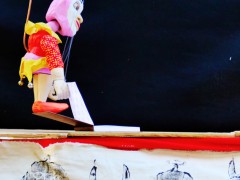The right to visual arts: a stimulus on education

The following article deals with the topic “Effective Investments in Education” which will be discussed at the Global Economic Symposium in Rio this October. The author intends to enrich the discussion at the symposium with her personal stories and ideas.
In the past few weeks I’ve been following the work realized by Ilha Design Project (Island Design), of which I am the author and coordinator, at the Full-time Education Center Monsenhor Pinto de Carvalho, a public school located at Enseada das Estrelas (Inlet Stars), on Ilha Grande (Big Island), Rio de Janeiro, Brazil.
Ilha Grande, a Biological Reserve, has a low income community and very little government investment, little access to information and other resources, besides predatory tourism. Ilha Design was created by Design students from The Federal University of Rio de Janeiro (Universidade Federal do Rio de Janeiro – UFRJ) under the guidance of Professor Celso Pereira Guimarães. The project’s main goal is to introduce Design as a way of social and cultural inclusion, which is essential for a better quality of life.
The inlet is known for its famous bag of Heaven, a bay of clear water where the sea shimmers, making people feel as if we are “sailing in the sky”. This is one of the many appeling features of the island. Thus the constant visitors end up promoting predatory tourism and leaving aside the value of local culture and education.
Natural beauty apart, the project brought the school, for the first time, some fun and engaging puppet theater performance of the artist Gilberto Conti, a Brazilian currently living in Prague, Czech Republic, where he works and studies the art of puppets.
The event was a splash! But even more impressive was what happened a week later. During the Arts workshops at the school, children were asked to draw what they saw during the event and by memory, this way, awakening their interest in art. These little seeds reproduced incredible details, from the material they have in mind while I myself make use of internet resources to do it. The children on the island do not have the resources that are commonly available for most people, since they are economically and technologically isolated. In addition to the visual stimulus, any event is important for students who do not receive motivations throughout their cultural academic life.
Every day we are peppered with a lot of visual information, but we are not educated to soak it up, and the encouragement of visual education is precarious when it should be used as a base, specially regarding education in preschool.
When we learn to read, the words are taught through the use of images or visual stimulus, but this method is not taken into consideration throughout academic process.
When it comes to arts education in Brazil, a compulsory subject in content in all grades, teaching is greatly left aside. Besides the low and scarce material resources (which leaves the teacher to continuous use of imagination only, spittle and chalk, to try to teach), the teaching of Art is also devalued by other disciplines that are not aware of the value visual education adds to the cultural, social and economic universe, facilitating the student’s learning and its knowledge acquiring.
Teaching how to look at the subject is a way to show alternative paths through Arts , braden horizons, stimulate creativity and enhance resources. Art should be part of people’s everyday life, especially for children who are starting their future, and the society’s in which they operate, promoting human dignity.
The look formation is an ongoing process and is not unique to arts classes, but it is present in all other fields: in geography maps, in math symbols, in the drawings used in science, and in a multitude of items that comprise the visual environment. Inserting teachers and students, especially preschoolers, in this universe is proposing that the change in the look and consequently in education begin from within, from school to community, from community to the world, for life.
In a world full of social differences and gaps, the investment in quality education it is extremely important. Education is the basis for change.
I like to quote the mathematician Pythagoras. This phrase is written on a rock at the entrance of Ilha Grande:
“Educate the children and there will be no need to punish men.”
The government still have time to bring this lesson to the history of our children’s life.




